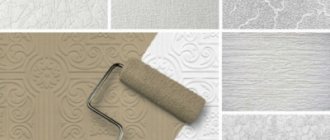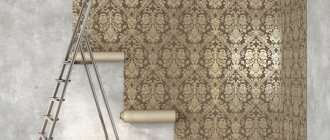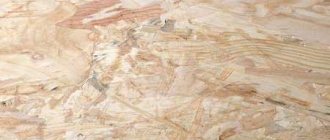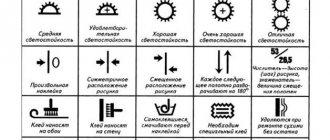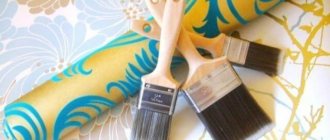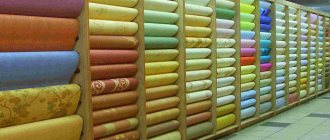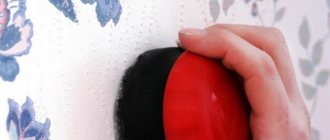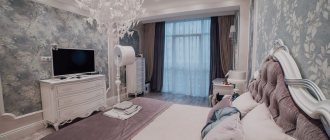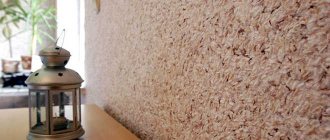Decorating walls with washable wallpaper is a common way to decorate apartments. After all, if for various reasons this piece of decor suddenly takes on an unpresentable appearance due to stains on it, you can always wash it. But this must be done taking into account the recommendations so as not to completely damage the coating, otherwise this can lead to unplanned repairs.
General tips and tricks
- Before washing, you need to understand the type of wallpaper. To do this, you need to look at the markings and then choose the best option.
- Even the most wear-resistant material will not withstand brute force; there is no need to scrub with a hard brush or use too much water.
- Before you begin removing stains, it is worth doing a test cleaning in the least visible place to make sure that the chosen method is correct.
What does the marking on the rolls mean?
Markings on the rolls indicate water resistance:
- one wave – low water resistance, can be treated with a slightly damp sponge,
- two waves - medium water resistance: wet washing is allowed, but caution is required,
- three waves – high resistance to moisture, can withstand treatment with household detergents,
- wave with a crest - the most durable material; the use of brushes and a washing vacuum cleaner is allowed.
What wallpaper can be washed?
Product marking
The marking allows you to understand whether the material can be washed. There are five common types.
- Marking in the form of a single wave indicates that the material is not suitable for wet cleaning; this type can be cleaned by wiping with light movements with a slightly damp cloth.
- Marking in the form of two horizontal waves allows you to wash the surface with a soft cleaning liquid, such as soap.
- Three horizontal waves mean that the surface can be washed with any cleaning liquid.
- The horizontal brush and wave allow you to wash the surface using mechanical means such as brushes, sponges, and vacuum cleaners.
- The horizontal brush and three waves mean maximum wear resistance, and the surface can be washed using chemical and mechanical means.
Kinds
Each type of wallpaper requires individual care; some of them can be washed, while others can only be cleaned using the dry method.
| Kinds | How to wash? | Photo |
| Non-woven | To maintain constant cleanliness, dust from embossed non-woven wallpaper can be cleaned with a dry cloth or using a vacuum cleaner. You need to wash according to the indicated markings. The smooth surface has water-repellent properties, which is very convenient for the kitchen; they can be washed with a damp cloth or sponge. For severe contamination, use washing liquids. | |
| Vinyl | Wallpaper can be washed with a damp cloth or napkin in a soapy solution. They also differ in moisture resistance; compact vinyl is the most resistant, but is afraid of chemical, abrasive and acidic substances. Vinyl with silk-screen printing differ in the production method; silk threads or artificial fibers are added to the composition. They have increased wear resistance and can be used for cleaning with a brush, vacuum cleaner and soapy water. | |
| Paper | Wallpaper is non-washable and requires careful care. It is not recommended to wash with water. You can clean them with a soft broom or dry cloth. An eraser will help remove fresh, non-greasy stains; you can also clean the stained area by ironing it with a hot iron through a sheet of white paper or a napkin. Old greasy marks cannot be removed without external damage. | |
| Liquid | The wallpaper has a soft surface. For regular care, use a vacuum cleaner or a soft broom. You can use an eraser to remove fresh marks. Old and deep stains can be replaced by making partial repairs. If wet, color may change. | |
| For painting | There are three main types, differing in the basis: paper, non-woven and glass wallpaper. Paper-based wallpaper can be cleaned with a dry cloth or vacuum cleaner. On a non-woven base, dirt can be removed with a damp cloth using gentle movements. | |
| Glass wallpaper | You can wash with a damp brush, but do not rub. A lot also depends on the paint applied. Water-based paint is wiped with a damp cloth. Acrylic and water dispersion using washing liquids and water. | |
| Bamboo wallpaper | Can be washed with a soft sponge using slightly concentrated non-abrasive cleaning liquids or cleaned with a vacuum cleaner. To avoid deformation, you should avoid overwetting the surface. Also, with constant contact with direct light, bamboo wallpaper can lose color. |
Features of the sticker
The sticker technology is no different from sticking simple wallpaper. However, they are significantly heavier, so you need to carefully select an adhesive that matches them. For metal types, dispersion adhesive with fungicidal additives is needed, acrylic and glass wallpaper are glued using acrylic glue, and for vinyl canvases, specialized compounds are used.
Some buyers make the mistake of believing that thick sheets will mask wall defects. But this is not true. The effectiveness of camouflage depends on the relief and elasticity of the stripes. Cork wallpaper will show even unnoticeable irregularities - their seams will simply not meet. Vinyl and acrylic are more effective in this situation, but not so much as to neglect preparing the walls before sticking.
How to wash washing wallpaper video:
Here are some expert tips for your attention:
- Before you start gluing, you must read the instructions included with the rolls (each manufacturer has its own specifics).
- They usually start gluing the canvases from the window.
- The edges of the strips should not be allowed to overlap each other. With a significant thickness of the stripes, such a seam will be noticeable like a wart on the nose.
Since the wallpaper is easily removed from the surface, if the joining is unsuccessful, the canvas can be removed and tried again. After obtaining a perfect joint, the edges of the coating must be ironed with a roller.
How can I clean wallpaper?
Tools
Several ways will help refresh your appearance and get rid of unwanted stains.
- Vacuum cleaner. It will help in caring for any type of wallpaper; it is enough to sometimes run a vacuum cleaner with a soft attachment along the dusty surface.
- Soft panicle. A way to regularly maintain cleanliness, eliminates dust.
- Dry cloth or soft rag. Eliminates dust.
- A sponge soaked in water or detergent. You can wash away stains and dirt.
- Alcohol wipes. Remove pen marks.
- Iron or hair dryer. Can be used to get rid of grease stains.
- Toothbrush. Removes heavy stains using washing powder (only for washing wallpaper).
- Cotton swab or cotton pad. Used for cleaning with alcohol.
- Wet wipes. Quickly remove dirt and stains.
What products can you use to clean wallpaper?
There are both folk remedies for getting rid of pollution, and professional ones, presented in specialized stores.
| Means | Cleaning | Photo |
| Soapy water | Grated soap diluted in water will help wash and refresh the surface. Suitable for cleaning vinyl, non-woven fabrics with a moisture-repellent coating, bamboo, and wallpaper painted with acrylic paint. | |
| Soda diluted with water | A slightly diluted solution will remove dirt from surfaces marked with maximum wear resistance. | |
| Professional products | The stores offer a wide selection of professional products suitable for any type of finishing. For example, HG wallpaper and painted wall cleaner. | |
| Dishwashing liquid | Using whipped foam or water with a small amount of product, you can wash dirty vinyl, bamboo, non-woven wallpaper with water-repellent properties. | |
| Talcum powder or chalk absorbs dirt and grease stains | Sprinkle the surface for a few minutes, after which you need to clean it with a dry cloth or simply shake it off. This method can be used to clean paper and vinyl wallpaper. | |
| Lemon | Half a lemon can be used to clear away dirt. Not suitable for paper-based wallpaper, paintable wallpaper or liquid wallpaper. | |
| Medical alcohol | A cotton pad soaked in alcohol will clean dirt from non-woven and compact vinyl wallpaper. | |
| Floor cleaning liquid | Can be used like dishwashing detergent. |
The main reasons for wallpaper contamination
Children's creativity is one of the most common reasons why wallpaper gets dirty.
Walls get dirty for various reasons. It can be:
- grease stains, paint;
- traces of writing objects: pen, felt-tip pen, pencil, ink;
- fingerprints;
- soot, soot;
- smoke due to tobacco;
- organic pollution;
- food stains.
Some stains can be removed by wiping them with a damp cloth. Others require more drastic measures, but chemicals can damage the coating. In such cases, the markings on the label will indicate the best cleaning methods.
How to wash, procedure
The most common and effective way to wash wallpaper in a room is with soapy water or cleaning products.
- To do this, it is worth conducting an experiment on a small area in order to understand how the wallpaper will react.
- A cleaning agent or soap is rubbed into a container with warm water, a clean rag is dipped into the solution, wrung out and a small area is wiped with gentle movements.
- Afterwards, wipe the surface with a clean, dry cloth.
Once the area is dry, the result will become visible. If you need to repeat the procedure, you should first wait until it dries completely, and then wash the area again.
General information
It often happens that washable wallpaper needs to be cleaned. This is not surprising, since this type of canvas is most often used in places where the walls are constantly dirty.
Such places include:
- Kitchen.
- Hallway.
- Children's room.
Therefore, when the surface of the walls begins to look quite dirty, it’s time to think about washing the wallpaper. What means are best to use for this purpose and what is most effective. Let's try to figure it out.
Stain removers
| Types of pollution | What to wash with? |
| Fat | Rub talcum powder or chalk into the stain, then clean with a rag; Use an iron to iron the stained area through a napkin or paper; Apply a cotton wool moistened with gasoline to the stain for several minutes. |
| Ballpoint pen and ink | You can clean it with a solution of potassium permanganate and vinegar, a solution of detergent and water, a melamine sponge, or rinse with half a lemon. |
| Felt pen | Clean the stained area with hydrogen peroxide, lemon juice or medical alcohol using a cotton swab. |
| Colour pencils | Rub with an eraser or toothbrush with washing powder. Gently wipe with solvent (vinyl wallpaper). Suitable for light surfaces. |
| Wax pencil and crayons | Dilute floor cleaner in water, rinse the surface and allow to dry. Or rub it with an eraser. |
| Fingerprints | Clean with an eraser, soda or talcum powder. Wash with soapy water. |
| Dye | Clean the stained area with acetone without touching the clean part of the wallpaper. You can try scraping off the dried paint. |
| Glue | Moisten a cloth with water and rinse the area of contamination using circular movements. |
| Plasticine | Gently scrape off with a knife and heat with a hairdryer, then clean the area with a slightly damp cloth. |
| Mold | Clean with a solution of baking soda in water, rinse with hydrogen peroxide. |
| Tobacco removal | Yellowness is difficult to remove. You can treat it with a vinegar solution and rub it with lemon juice. |
| Soot | To begin with, the walls can be cleaned with a vacuum cleaner. Then use a dry cleaning sponge, washing liquid or solvent. Paper wallpaper cannot be cleaned without damage; it is better to remove the old ones and stick on fresh ones. |
| Zelenka | Rinse with a solution of lemon juice, alcohol and water. Clean with hydrogen peroxide. |
| Pomade | Wash with soapy water or foam detergent. |
| Wine | Fresh stains can be washed with soapy water. An old stain is almost impossible to clean. |
With proper regular care, you can extend the life of your wallpaper and maintain the brightness of the colors. A little trick and a product that you almost always have on hand will help you get rid of unexpected stains and wash away dirt. It is important to remember that each type of wallpaper has a different composition and interacts with water differently; in order to avoid troubles, you need to take into account the instructions on the label.
Household tricks
Depending on the nature of the dirt, you can use small tricks to clean the walls. For example, to remove fingerprints, there is no need to make a soap solution. Simply rub the stains gently with an eraser. You can also rub them with bread - bread gluten effectively copes with such problems.
Grease stains can cause a lot of trouble, because they cannot be removed with water. But talc removes them well. You should pour it on a sponge and rub the stained area. You can also use an iron. Apply a paper napkin to the stain on the wall and iron the coating through it. Some of the fat will transfer to the napkin, and the rest can be removed with regular wet cleaning.
If there are small children in the house, then it is useful to know how to clean wallpaper from felt-tip pens. Regular coating cannot be cleaned, only washable one. Therefore, covering a children's room with washable wallpaper is a good solution.
- If the markers are water-based, then cleaning the wall will be very simple: just wipe it with a damp cloth.
- To remove marks from alcohol markers, properly treat the stained areas with alcohol or vinegar. Citric acid will also work. You need to moisten a cotton pad in one of these products and wipe the coating. Then you can begin regular cleaning. It may not be possible to remove traces of the baby’s creative impulse the first time, then the procedure will have to be repeated.
It is important to remember that if you wash wallpaper very often, it will wear out quickly. The more often you do this, the sooner the need for repairs will arise. Therefore, wet cleaning should be used only when necessary. Still, washable wallpaper is an excellent solution for rooms where there is a risk that the coating will often get dirty. If you adhere to the rules for using wallpaper, take into account its technical characteristics and wash it carefully, then it will last quite a long time.
A few tips on how to stop a cat from tearing up wallpaper

